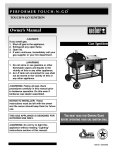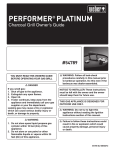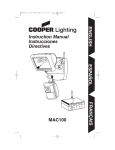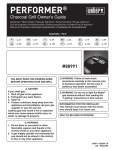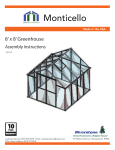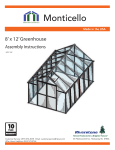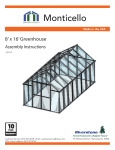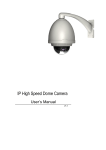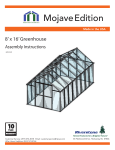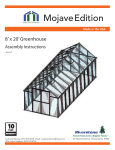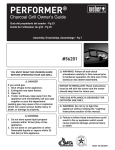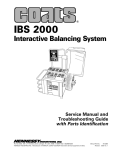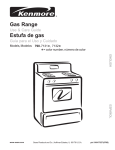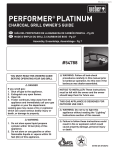Download Weber 3994601 User's Manual
Transcript
PERFORMER ™ TOUCH-N-GO IGNITION ™ Owner’s Manual Serial Number Please use this number in registering your warranty and any correspondence with the factory. 200 200 200 200 200 200 200 200 ® 200 200 200 ® WARNING: Follow all leak check procedures carefully in this manual prior to barbecue operation. Do this even if barbecue was dealer assembled. NOTICE TO INSTALLER: These instructions must be left with the owner and the owner should keep them for future use. THIS GAS APPLIANCE IS DESIGNED FOR OUTDOOR USE ONLY. WARNING: Do not try to light this appliance without reading "Lighting" instructions section of this manual. FOR YOUR SAFETY 1. Do not store or use gasoline or other flammable vapors and liquids in the vicinity of this or any other appliance. 2. An LP tank not connected for use shall not be stored in the vicinity of this or any other appliance. FOR YOUR SAFETY If you smell gas: 1. Shut off gas to the appliance. 2. Extinguish any open flame. 3. Open lid. 4. If odor continues, immediately call your gas supplier or your fire department. 3994601 11/96 DANGER Failure to follow the Dangers, Warnings and Cautions contained in this Owner’s Manual may result in serious bodily injury or death, or in a fire or an explosion causing damage to property. WARNINGS ■ ■ ■ ■ ■ ■ ■ ■ ■ ■ ■ ■ ■ ■ ■ ■ ■ ■ ■ ■ ■ ■ ■ ■ ■ ■ ■ ■ ■ Do not store a spare or disconnected LP tank under or near this barbecue. Improper assembly may be dangerous. Please follow the assembly instructions in this manual. Combustible materials should never be within 24 inches of the top, bottom, back or sides of the barbecue. Do not put a barbecue cover or anything flammable on or in the storage area under the barbecue. Do not use lava or char rocks in your barbecue. Never lean over the barbecue when lighting the gas burner. Barbecue should be thoroughly cleaned on a regular basis. Do not use gasoline, liquid fire starter or alcohol on the charcoal at any time. Do not use any form of selflighting charcoal at any time. Infants, children and pets should never be left unattended near the barbecue. Make sure ash catcher is in place when using the barbecue. Always remove the lid before lighting the gas burner, either manually or with the igniter. Lid must remain OFF until charcoal is fully ignited. Always put charcoal in Char-Baskets or on top of the lower (charcoal) grate. Do not put charcoal directly in the bottom of the bowl. Remove ashes from the ash catcher only after all coals have been fully extinguished. Never touch grates (charcoal and cooking), ashes or coals to see if they are hot. Do not use water to control flare-ups or extinguish coals, as it may damage the porcelain finish; slightly close bottom air vents (dampers) and use the lid. To extinguish coals when finished cooking, close all vents (dampers) after putting lid on the bowl. Barbecue mitts should always be worn while cooking, adjusting air vents (dampers), adding charcoal, and handling the thermometer or lid. Never dump hot coals where they might be stepped on or be a fire hazard. Never dump ashes or coals before they are fully extinguished. Do not store barbecue until ashes and coals are fully extinguished. After a period of storage and/or nonuse, check for gas leaks and burner obstructions before using. See instructions in this manual for correct procedures. Do not operate the barbecue if a gas leak is present. Do not use a flame to check for gas leaks. Should the burner go out at any time during operation, turn tank valve off. Remove lid and wait five minutes before attempting to relight, using the lighting instructions in this manual. The conversion or attempted use of natural gas in this barbecue is dangerous and will void your warranty. Do not attempt to disconnect the gas regulator from the tank or any gas fitting while the barbecue is in use. Use only the LP gas regulator that is supplied with your barbecue. A dented or rusty LP tank may be hazardous and should be checked by your liquid propane supplier. Do not use an LP tank with a damaged valve. Although your LP tank may appear to be empty, it may still contain gas. The tank should be transported and stored accordingly. If you see, smell or hear gas escaping from the LP tank: 1. Get away from the LP tank. 2. Do not attempt to correct the problem yourself. 3. Call your fire department. Use only the LP tank supplied with your barbecue. Do not connect anything larger than a 5 lb cylinder. You should exercise reasonable care when operating your barbecue. It will be hot during cooking and/or cleaning, and should never be left unattended. 2 WARRANTY Weber Stephen Products Co. (Weber) hereby warrants to the ORIGINAL RETAIL PURCHASER of this Weber Barbecue that if it is assembled and operated in accordance with the printed instructions accompanying it then for a period of one (1) year from the date of purchase, the cooking grate, charcoal grate, Char-Basket™ Fuel Holders and the tank shall be free from defects in material and workmanship; and for three (3) years from the date of purchase, the burner assembly, igniter, hose, test valve and regulator shall be free from defects in material and workmanship; and for five (5) years from the date of purchase all other parts shall be free from defects in material and workmanship. This Limited Warranty does not cover any failures or operating difficulties due to accident, abuse, misuse, alteration, misapplication, improper installation or improper maintenance or service, or failure to perform normal and routine maintenance, including but not limited to damage caused by insects within the burner tubes, as set out in this owner's manual. There are no other express warrants except as set forth herein and any applicable implied warranties of merchantability and fitness are limited in duration to the period of coverage of this express written Limited Warranty. Some states do not allow limitation on how long an implied warranty lasts, so this limitation may not apply to you. Weber may require reasonable proof of your date of purchase. THEREFORE, YOU SHOULD RETAIN YOUR SALES SLIP OR INVOICE AND RETURN THE WEBER LIMITED WARRANTY REGISTRATION CARD IMMEDIATELY. Weber is not liable for any special, indirect or consequential damages. Some states do not allow the exclusion or limitation of incidental or consequential damages, so this limitation or exclusion may not apply to you. Weber does not authorize any person or company to assume for it any other obligation or liability in connection with the sale, installation, use, removal, return, or replacement of its equipment; and no such representations are binding on Weber. This Limited Warranty shall be limited to the repair or replacement of parts which prove defective under normal use and service and which on examination shall indicate, to Weber's satisfaction, they are defective. Before returning any parts, contact WeberStephen Products Co. Customer Service Center. If Weber confirms the defect and approves the claim, Weber will elect to replace such parts without charge. If you are required to return defective parts, transportation charges must be prepaid. Weber will return parts to the purchaser, freight or postage prepaid. This Warranty applies only to products sold at retail. WEBER-STEPHEN PRODUCTS CO. Customer Service Center 250 South Hicks Road Palatine, IL 60067-6241 (800) 446-1071 3 PATENTS AND TRADEMARKS © 1996 Weber. Weber, , the kettle configuration, One-Touch and Performer are registered U.S. trademarks; Char-Basket, CharBin, Touch-N-Go and Tuck-Away are U.S. trademarks of WeberStephen Products Co., 200 East Daniels Road, Palatine, IL 60067-6266. U.S.A. The Performer is covered under the following patent nos.: U.S.A.: #RE33,091; #D327,390; #4,777,927; #4,941,817; #4,966,125; #5,036,832; #5,076,252; #5,215,075 and other patents pending; Canada: #1,168,124 and #1,283,586. Printed in the U.S.A. 4 Contents Operating Instructions Lighting........................................................ 18-19 Cooking ............................................................ 20 Cleaning ........................................................... 21 Storage............................................................. 21 LP Tank Information.................................... 21-23 Troubleshooting & Maintenance Troubleshooting................................................ 24 Maintenance................................................ 25-27 Parts Listing .............................................................. 29 WARNINGS ................................................................ 2 Warranty & Patents.................................................. 3-4 General Instructions.................................................... 6 Assembly ............................................................... 7-17 j d i k l a b c e h g f FEATURES: a) Exclusive Touch-N-Go™ Gas Ignition System takes the hassle out of lighting charcoal briquets. Simply push a button and the system's gas burner ignites, starting the charcoal for you. No dangerous liquid starters to use or store, and no more liquid starter aftertaste. b) The 5 lb LP tank that is provided with your barbecue will last for approximately 150 lightings at normal use (each lighting lasting 3 to 5 minutes). c) CharBin™ Storage Container holds over 20 lbs of charcoal within easy reach. d) Stainless steel CharBin lid serves as a great work area and covers the CharBin Storage Container to keep briquets dry. e) Stainless steel cooking grate holder. f) Convenient bottom rack for storage. g) High-capacity ash catcher locks in place, eliminating blowing ashes. h) One-Touch® Cleaning System easily sweeps out ashes, or opens and closes the vents. i) Patented Dual-Purpose Thermometer monitors the cooking temperature inside the grill and can also be used as a probe to quickly check the doneness of food. j) Tuck-Away™ Lid slides back into the stainless steel lid holder and acts as a windshield when lighting briquets. k) Hinged access flaps swing open on cooking grate for easy addition of briquets or wood chips during cooking. l) Char-Basket™ Fuel Holders allow convenient Indirect and concentrated Direct cooking flexibility with wood or charcoal. IMPORTANT NEW FEATURES: Your Weber Gas Barbecue is equipped with a new and improved LP tank connection, that has additional safety features. They are: 1. The connection of the barbecue to the LP tank can be made without the use of tools. 2. The new connection will not permit the flow of gas until a positive gas connection is made. 3. If an accidental fire occurs at the LP tank connection, the flow of gas is stopped by a temperature activated shutoff. 4. If the LP supply hose becomes damaged, cut, punctured, or accidentally fire damaged, the barbecue connection is equipped with an excess flow control that will limit the flow of gas if leakage or a fire occurs. 5 General Instructions Your Weber Performer Grill with Touch-N-Go Gas Ignition is a portable outdoor cooking appliance. You can grill, barbecue, roast and bake with results that are difficult to duplicate with indoor kitchen appliances. Operating area WARNING: Only use this barbecue outdoors in a well-ventilated area. Do not use in a garage, building, breezeway or any other enclosed area. The Performer Grill is portable so you can easily change its location in your yard or on your patio. Portability means you can take your Weber Charcoal Barbecue with you if you move. ■ These instructions will give you the minimum requirements for assembling your Performer Grill. Please read the instructions carefully before using your grill. Improper assembly can be dangerous. ■ Not for use by children. ■ The pressure regulator supplied with the Weber Barbecue must be used. This regulator is set for 10.5 inches of water column (pressure). ■ The Weber Performer Grill with Touch-N-Go Gas Ignition is designed for use with liquid propane (LP) gas only. Do not use with natural (piped in city) gas. The valves, orifices, hose and regulator are for LP gas only. The gas must be turned OFF at the LP tank when the grill is not in use. ■ When the Performer Grill is stored indoors, the gas supply MUST BE DISCONNECTED and the LP tank stored outdoors in a well-ventilated space. ■ LP tanks must be stored outdoors in a wellventilated area out of the reach of children. Disconnected LP tanks must not be stored in a building, garage or any other enclosed area. ■ When the LP tank is not disconnected from the Performer Grill, the appliance and LP tank must be kept outdoors in a well-ventilated space. ■ Check that the areas around the tank, hose and burner assembly are free from debris that might obstruct the air flow of gas or air. Never use your Performer Grill under an unprotected combustible roof or overhang. ■ Your Weber Gas Barbecue is not intended to be installed in or on recreational vehicles and/or boats. ■ Do not use combustible materials within 24 inches of the top, bottom, back or sides of the grill. ■ The entire barbecue gets hot when in use. Do not leave unattended. ■ Keep any electrical supply cord and the fuel supply hose away from any heated surface. ■ Keep the cooking area clear of flammable vapors and liquids, such as gasoline, alcohol, etc., and combustible materials. LP Tank The LP tank manufacturer is responsible for the materials, workmanship and performance of the tank. If the tank has a defect, malfunctions, or you have a question regarding the tank, call the tank manufacturer's customer service center. The phone number is on the warning decal which is permanently attached to the tank. If the tank manufacturer has not resolved the issue to your satisfaction, then call Weber-Stephen Products Co., Customer Service Center. Storage ■ ■ 6 ASSEMBLY INSTRUCTIONS Tools needed Check package contents The following item will be found in the top box. Phillips screwdriver Bottom rack 7/16 inch and 7/8 inch or an adjustable wrench Pliers The following items will be found in the large box (shipper). Hammer CharBin Storage Container Block of wood Supplies needed Your LP tank is shipped empty for safety. You will need to fill it (See Step "Fill LP tank"). You will need a soap and water solution to check for gas leaks. Bowl assembly Packages Your Weber Performer Grill comes in a large box (shipper) which includes a top box, and bottom carton. There is a hardware pack of small parts and hardware that will be found in the bottom carton. Note - The hardware size of nuts, bolts and screws is given. For example "1/4-20 x 1/2 inch bolt" means a bolt 1/4 inch in diameter with 20 threads to the inch, 1/2 inch long. On a small screw, "8-18 x 5/8 inch screw" means a number 8 screw, with 18 threads to the inch, 5/8 inch long. Lid assembly While we give much attention to our products, unfortunately an occasional error may occur. If a part is missing, do not go back to the store. Call the Weber Customer Service Center toll free 1-800-446-1071 to receive immediate assistance. Have your owner’s manual and serial number available for reference. Ash catcher assembly Two Char-Basket Fuel Holders 7 LP tank Tank holder assembly Filler adapter Control panel The following items will be found in the bottom carton. Bowl panel Wheel frame Two bottom connectors Charcoal grate Front panel Hinged cooking grate WE BE Two wheels WE B E R Burner cleaning tool/ match holder Caster frame assembly R Top frame assembly Axle 8 The following items will be found in the hardware pack. Step 1 Assemble wheels You will need: axle, two wheel hubcaps, two wheels, wheel frame, hammer and a block of wood. Sixteen nylon washers (actual size) Place one end of the axle on the block of wood (or other protected surface). Tap on one hubcap. Put one wheel on the axle, WEBER side toward the hubcap. Slide the axle through the frame. Add the other wheel, WEBER side out. Tap on the hubcap. Figure 1. WE BE WE B E R Four aluminum washers (actual size) R Eight 1/4-20 x 1 3/4 inch bolts (actual size) Four 1/4-20 acorn nuts (actual size) Figure 1 Four 1/4-20 x 1/2 inch bolts (actual size) Three tool holders Three hubcaps 9 Step 2 Step 3 Remove protective packaging Assemble the frame Protective cardboard inserts must be removed from the bowl before assembly. Figure 2. DO NOT FORCEFULLY REMOVE THE INSERTS. You will need: top frame assembly, wheel frame assembly and caster frame assembly. Note - Work on soft surface (grass, or carton inserts) to protect the finish during frame assembly. a) Remove cardboard insert from ash catcher ring. Be careful when removing the cardboard not to bend the ash catcher ring. Set the top frame on the ground so the leg tabs point up. Fit the wheel frame assembly onto the leg tabs at the open end of the top frame. Figure 3. b) Tear cardboard along the perforations at leg couplings and pull downward. Fit the caster frame assembly onto the leg tabs at the other end of the top frame. Figure 3. c) Peel off the protective plastic covering from the nameplate on the ash catcher ring. The tabs must be on the inside of the frame tubes when the joints are closed. Figure 3 (a). (a) (c) (b) (b) Tab on the inside of frame tube Figure 2 (a) Figure 3 10 Step 4 Step 5 Continue frame assembly Complete frame assembly You will need: frame assembly, front panel, four 1/2 inch bolts, four nylon washers and a 7/16 inch open-end or an adjustable wrench. You will need: two bottom connectors, tank holder assembly, four 1 3/4 inch bolts, four nylon washers and a 7/16 inch open-end or an adjustable wrench. Place front panel along inside edge of frame assembly with Weber logo on the side closest to the wheel frame and facing out. Slip washers on bolts, insert bolts through the front panel and screw into the frame assembly. Figure 4. Turn over partial frame assembly and remove twist tie from CharBin lid. Hold one bottom connector between wheel and caster frames, below front panel. Place washer on bolt, insert through wheel frame and screw into bottom connector. Figure 5. Add the remaining bolts and washers to the other side of the frame and tighten. Figure 4. Lift open CharBin lid. Insert tank holder assembly tabs into the slots in the frame brace. Figure 5 (a). Slide up until the notch at the bottom of the tank holder assembly fits over the cross brace of the caster frame. Figure 5 (b). Weber nameplate facing out Place washer on bolt, insert through tank holder assembly and frame, and screw into bottom connector. Do not fully tighten bolts until both bottom connectors are in place. Hold the other bottom connector between wheel and caster frames. Add washers to bolts. Insert bolts through frame and screw into bottom connector. Figure 5. Tighten all four bolts. Slots in frame brace Figure 4 (a) CharBin lid (b) Install this bolt first Bottom connector Figure 5 11 Step 6 Step 7 Uncover CharBin lid Install bowl assembly Remove protective plastic covering from CharBin lid. Figure 6. You will need: bowl assembly, four 1 3/4 inch bolts, eight nylon washers, four aluminum washers, four acorn nuts, 7/16 inch open-end or adjustable wrench and pliers. CharBin lid Set bowl assembly in open end of frame with lid holder to the outside, and align mounting brackets over holes in frame. Figure 7. Slip a nylon washer on a bolt and insert bolt through bowl mounting bracket and frame. Place a nylon washer then an aluminum washer and acorn nut on end of bolt. Figure 7. Repeat for the other three bolts. Do not tighten until all four bolts are correctly in place. CAUTION: Do not overtighten the bolts. Overtightening can fracture the porcelain. Figure 6 Nylon washers Aluminum washer Lid holder Figure 7 12 Step 8 Step 9 Install igniter Fill LP tank Note - The igniter wires have been attached to the igniter for factory testing of the ignition system. There is no need to disconnect for installation. Figure 8 (a). Note - The LP tank manufacturer is responsible for the materials, workmanship and performance of the tank. If the tank has a defect, malfunctions, or you have a question regarding the tank, call the tank manufacturer's customer service center. The phone number is on the warning decal which is permanently attached to the tank. If the tank manufacturer has not resolved the issue to your satisfaction, then call Weber-Stephen Products Co., Customer Service Center. The igniter assembly is taped to the burner assembly. Remove the tape and insert top part of igniter through the large part of the keyhole. Loosen the igniter lock nut and slide igniter to the narrow end of the keyhole with the igniter gasket above the frame brace. Tighten the igniter lock nut. Figure 8 (b). Take the LP tank to an RV center (or some other source of LP gas) to fill the tank with only 5 lbs of liquid propane. Note - If the igniter works loose in the frame, carefully tighten the igniter lock nut with an adjustable wrench or pliers. WARNING: We recommend that your LP tank be filled at an authorized LP gas dealer by a qualified attendant, who fills the tank by weight. Igniter Igniter gasket IMPROPER FILLING IS DANGEROUS. Igniter lock nut Tell your LP dealer that this is a new LP tank. The air must be removed from a new LP tank before the initial filling. Your LP tank dealer is equipped to do this. White igniter wire CAUTION: If you exchange your LP tank, make sure you get a similar tank in return. Your LP tank is equipped with a quick-disconnect valve. Other LP tanks are not compatible with your barbecue connection. Black igniter wire (a) The LP tank must be installed, transported and stored in an upright position. LP tank should not be dropped or handled roughly. Never store or transport the LP tank where temperatures can reach 125° Fahrenheit (too hot to hold by hand – for example: do not leave the LP tank in a car on a hot day). For full instructions on safe handling of LP tanks, see Section "Operating Instructions". Note - A refill will last for approximately 150 lightings at normal use (each lighting lasting 3 to 5 minutes). LP tank does not have to be empty before refilling. (b) Figure 8 Igniter lock nut Key hole in frame brace 13 Step 10 The hose and regulator are connected in the following manner: Install and connect filled LP tank Slide back the collar of the quick disconnect on the tank valve. Figure 10 (a). Push the male fitting of the regulator into the quick disconnect, and maintain pressure. Slide the collar closed. Figure 10 (b) shows the quick disconnect engaged. Figure 10 (a) shows various components of the tank and regulator. WARNING: Make sure that the LP tank valve is closed. Close by turning clockwise. Hook LP tank onto tank holder assembly. The square hole on the tank collar fits over the top lip of the tank holder assembly. Figure 9 (a). Regulator The bottom of the tank rests firmly on the lower lip of the tank holder assembly. Figure 9 (b). Valve handwheel (a) Test valve Top lip of tank holder assembly Tank valve (a) Pressure relief valve Hose (b) Figure 10 (b) Bottom lip of tank holder assembly Figure 9 14 Step 11 If bubbles occur, or if a bubble enlarges, the connection is leaking. Turn OFF the gas at LP tank. Check for gas leaks If the leak is at connection a) DO NOT OPERATE THE BARBECUE. Contact your dealer. DANGER If the leak is at connection b) disconnect and reconnect the quick disconnect fitting. Turn the gas back on and recheck with the soap and water solution. Do not use an open flame to check for gas leaks. Be sure there are no sparks or open flames in the area while you check for leaks. This will result in a fire or explosion which can cause serious bodily injury or death and damage to property. WARNING: If leak persists after tightening the connection, turn OFF the gas at LP tank. DO NOT OPERATE THE BARBECUE. Contact your dealer. After completing the leak checks: a) Turn the LP tank valve OFF (clockwise) and rinse connections with water. WARNING: Check for gas leaks every time any gas fitting is disconnected and reconnected. b) Turn the test valve to the OPEN position (parallel to the hose). Figure 12. You will need: a soap and water solution and a rag or brush to apply it. Note - Since some leak test solutions, including soap and water, may be slightly corrosive, all connections should be rinsed with water after checking for leaks. To perform leak checks: Turn test valve to the CLOSED position. Figure 11. Turn tank valve ON (counterclockwise). Check for leaks by wetting the connections with the soap and water solution and watching for bubbles. Check the following connections, as shown in figure 11: a) Test valve to regulator connection. Test valve must be in OPEN position when operating grill b) Quick disconnect fitting to LP tank connection. Figure 12 (b) (a) Test valve in CLOSED position Test valve in OPEN position Figure 11 15 Step 12 Note: Before sliding the CharBin into place check that the Cooking grate holder is sitting loosely on the frame brace and is conforming to the frame brace. Figure 14 a. If it is tight or stuck over the edge of the frame brace, Figure 14 b, reposition as in Figure 14 a. Add bowl panel, tool holders and CharBin Storage Container You will need: bowl panel, three tool holders and CharBin Storage Container. Remove protective plastic covering from bowl panel. Slide the ends of bowl panel under bowl mounting brackets so the ends rest on tabs inside frame. Set the panel in place on top of the frame brace. Figure 13. If the Cooking grate holder is not correctly positioned, it could allow the CharBin to slide through the frame. Slide CharBin down into the top frame with the deep end toward the rear. Figure 14. Hook the tool holders over the frame rail. There is a cut-out on the right side of the front panel to accommodate the tool holders. Figure 13. Inside of Frame Brace (a) Cooking grate holder (a) (b) Tab CharBin Bowl panel Figure 14 Tool holders Figure 13 16 Step 13 Step 14 Install ash catcher, control panel & bottom rack Add grates, Char-Basket Fuel Holders and lid You will need: ash catcher, control panel and bottom rack. You will need: charcoal grate, Char-Baskets, hinged cooking grate and lid. Align handle and prongs of ash catcher with their appropriate slots on the ash catcher ring. The handle fits into the larger slot. Figure 15 (a). Place charcoal grate on bottom supports in bowl. Set Char-Baskets on charcoal grate, cooking grate on top supports, and lid on bowl. Figure 16. Lift ash catcher up into slots and rotate to the right. Ash catcher will fit securely into place. Figure 15 (b). Set control panel in place over igniter and LP tank handwheel. Figure 15. Slide bottom rack into position between bottom connectors. Figure 15. Control panel (a) (b) Figure 16 Ash catcher handle Figure 15 17 OPERATING INSTRUCTIONS Lighting 4) Position filled Char-Baskets over burner. Figure 3. Char-Basket Fuel Holders DANGER Open lid before lighting. Do not use any flammable liquids such as starting fluid, gasoline, alcohol or any form of self-lighting charcoal at any time, including when manually lighting. Failure to do so will cause serious bodily injury or death. Burner WARNING: Check hose before each use of barbecue for nicks, cracking, abrasions or cuts. If the hose is found to be unserviceable do not use barbecue. Replace using only Weber factory authorized replacement parts. Order from Weber-Stephen Products Co., Customer Service Center, or authorized dealer. Figure 3 1) Open lid. 2) Clear any ashes from the bowl by moving the control rod side to side. Figure 1. 5) Turn gas supply ON (counterclockwise) at LP tank. WARNING: Do not lean over open barbecue while lighting. CAUTION: Be sure that burner slots are free of any ash or obstructions before lighting. 6) Push igniter button until burner ignites. Control rod CAUTION: Flame may be difficult to see on a bright day. CAUTION: Your LP tank connection is equipped with an excess flow device. If it activates it reduces the flow of gas to the burner. If this should occur turn OFF the LP tank and turn the test valve OFF. Wait 5 minutes for the gas to clear. Then turn ON the LP tank and slowly turn the test valve ON and try to ignite again. Figure 1 3) Open bottom bowl vents. Figure 2. Closed WARNING: If burner fails to ignite, turn tank valve handwheel OFF. Wait five minutes for gas to clear and follow Manual Lighting Instructions. Open 7) Turn gas supply OFF after charcoal has started to burn (approximately 3-5 min.). Note - If you are cooking using the Indirect method, separate your Char-Baskets after turning gas supply OFF. Wear barbecue mitts and use long-handled tongs. 8) You can begin cooking when briquets have a light coating of grey ash (approx. 25-30 minutes). Figure 2 18 Manual Lighting Insect Alert WARNING: Do not attempt to light manually without using the match holder. Your Performer Grill, as well as any outdoor gas appliance, is a target for spiders and insects. They can nest in the venturi section of the burner tube causing gas to flow back out of the air shutter. Figure 5. This could result in a fire in and around the burner tube under the bowl panel. It can cause serious damage to your barbecue, rendering it unsafe to operate. 1) Open lid. 2) Open bottom bowl vents. 3) Move Char-Baskets away from the burner. 4) Put a match in the match holder. Light match. We strongly recommend that you inspect and clean the burner tube at least once a year, or if any of the following symptoms occur: 5) Position match flame at rear of burner slot. Figure 4. WARNING: Do not hold hand directly above burner when manually lighting. 1. The smell of gas in conjunction with the burner flames appearing very yellow and lazy. 2. Burner makes popping noises. DANGER Failure to correct these symptoms may result in a fire which can cause serious bodily injury or death and cause damage to property. Orifice clip Hose fitting Figure 4 Venturi WARNING: Do not lean over open barbecue while lighting. Air shutter 6) Turn gas supply ON at the tank and check for ignition. CAUTION: Flame may be difficult to see on a bright day. Figure 5 CAUTION: Your LP tank connection is equipped with an excess flow device. If it activates it reduces the flow of gas to the burner. If this should occur turn off the LP tank and turn the test valve OFF. Wait 5 minutes for the gas to clear. Then turn on the LP tank and slowly turn the test valve ON and try to ignite again. 7) Wear barbecue mitts and use tongs to reposition Char-Baskets over burner. 8) Turn gas supply OFF after charcoal has started to burn (approximately 3-5 min.). 19 Cooking Methods Direct Method For foods requiring fewer than 30 minutes of cooking time, cook directly over the coals, absorbing the full heat. 1. Fill each Char-Basket with 25 briquets and place with flat sides together in center of charcoal grate. 2. Ignite charcoal (approx. 3-5 minutes), then turn OFF gas supply at the tank. 1. Place filled Char-Baskets with flat sides together in center of charcoal grate. 2. Ignite charcoal (approx. 3-5 minutes), then turn OFF gas supply at the tank. 3. Move Char-Baskets to opposite sides of the kettle immediately after ignition (approx. 3-5 min.). Wear barbecue mitts and use long-handled tongs. 3. Coals are ready when they have a light coating of grey ash (approx. 25-30 minutes). 4. Place drip pan in the center of the charcoal grate between the Char-Baskets. 4. Put hinged cooking grate in place. 5. Set hinged cooking grate in place with the “flaps” directly over the Char-Baskets. 5. Place meat directly over coals to sear, then move food to the perimeter of the cooking grate. 6. Coals are ready when they have a light coating of grey ash (approx. 25-30 minutes). 6. Close lid and cook according to directions. 7. Place food on the cooking grate directly above the drip pan. For cooking large quantities of food, charcoal can be piled in a pyramid in the center of the charcoal grate, ignited and spread over the charcoal grate for a larger Direct cooking area. 8. Close lid and cook according to directions. Note - For meat that requires more than one hour of cooking time, 8 additional coals must be added at the end of each hour. The “flaps” on the cooking grate can be opened to easily add charcoal to the baskets. Wear barbecue mitts and use long handled tongs to lift “flaps” and add coals. Indirect Method For cooking whole meats such as roasts, turkeys or hams, Char-Baskets are placed on the sides of the kettle to circulate the heat like a convection oven. It is important in Indirect Cooking to have the coals burning equally well on each side before beginning to cook. Occasionally when the coals are ignited, one side will start faster than the other. If this happens, wear BBQ mitts and use long-handled tongs to move the charcoal from one side to the other so the heat is evenly distributed. When cooking by the Indirect method, Char-Baskets should be positioned as shown in figure 6 with the “flaps” of the hinged cooking grate directly above the baskets. This is for safety reasons so the user can avoid reaching directly over burning coals. For additional information and cooking times, consult the Weber Owner's Guide. A few wood chunks or a handful of cooking woodchips may be added to hot coals for a mild smoke flavor in your foods. CAUTION: Replace thermometer in lid when not in use. Do not leave thermometer in food while cooking. Figure 6 20 Periodic Cleaning Storage To remove ashes from the bowl, move control rod side to side so damper blades sweep ashes through the bowl vents and into the ash catcher. Figure 7. ■ When the Performer Grill is stored indoors, the gas supply MUST BE DISCONNECTED and the LP tank stored outdoors in a well-ventilated space. ■ LP tanks must be stored outdoors in a wellventilated area out of the reach of children. Disconnected LP tanks must have threaded valve plugs tightly installed and must not be stored in a building, garage or any other enclosed area. ■ After a period of storage and/or nonuse, the barbecue should be checked for gas leaks and any obstructions in the burner tube before using. (See section “Maintenance.”) ■ Check that the areas around the tank, hose and burner assembly are free from debris that might obstruct the flow of gas or air. Control rod Figure 7 CAUTION: Be sure that burner is OFF and barbecue is cool before cleaning. Refilling the LP tank Do not enlarge burner slots when cleaning. Removal of the LP tank To clean burner: Brush the outside of the burner tube and the burner slot section with a brass wire brush. Figure 8. 1) Close tank valve (turn clockwise). 2) Slide the collar back on the quick disconnect to disengage the fitting. Figure 9. Burner slot Tank valve Figure 8 CAUTION: Do not enlarge the burner slots or the gas orifice when cleaning. TO CLEAN KETTLE: ■ ■ While lid is warm, wipe the inside with a paper towel to prevent grease buildup. Figure 9 For outer surfaces use a warm soapy water solution and rinse well with clear water. 3) Lift tank off. To refill take LP tank and tank filler adapter to a "Gas Propane" dealer. For a more thorough cleaning (to be done at least once a year): WARNING: We recommend that your LP tank be filled at an authorized LP gas dealer, by a qualified attendant, who fills the tank by weight. IMPROPER FILLING IS DANGEROUS. 1. Remove ashes after coals are fully extinguished. 2. Remove the grates and Char-Baskets. 3. Clean the porcelain finish with with a spray-on type oven cleaner. Spray surfaces heavily with the oven cleaner and leave on long enough to soften accumulated grease. CAUTION: If you exchange your LP tank, make sure you get a similar tank in return. Your LP tank is equipped with a quick-disconnect valve. Other LP tanks are not compatible with your barbecue connection. 4. Wipe out with paper towels. Wash with a mild detergent and water. Rinse well with clear water and wipe dry. 21 Connecting the LP tank Check the following connections, as shown in figure 11: a) Test valve to regulator connection. WARNING: Make sure LP tank valve is closed. Close by turning clockwise. b) Quick disconnect fitting to LP tank connection. If bubbles occur, or if a bubble enlarges, the connection is leaking, turn OFF the gas at LP tank. You will need: filled LP tank, a soap and water solution and a rag or brush to apply it. If the leak is at connection a) DO NOT OPERATE THE BARBECUE. Contact your dealer. Lift LP tank onto tank holder. Slide back the collar of the quick disconnect on the tank valve. Figure 10 (a). Push the male fitting of the regulator into the quick disconnect, and maintain pressure. Slide the collar closed. Figure 10 (b). If it does not engage or lock, repeat procedure. Gas will not flow unless the quick disconnect is properly engaged. (a) (a) (b) Quick disconnect retracted Male fitting Regulator (b) Collar Test valve in CLOSED position Figure 11 Quick disconnect engaged If the leak is at connection b), disconnect and reconnect the quick disconnect fitting. Turn the gas back on and recheck with the soap and water solution. Figure 10 Mix soap and water. WARNING: If leak persists after tightening the connection, turn OFF the gas at LP tank. DO NOT OPERATE THE BARBECUE. Contact your dealer. Open the tank valve. DANGER After completing the leak checks: Do not use an open flame to check for gas leaks. Be sure there are no sparks or open flames in the area while you check for leaks. This will result in a fire or explosion which can cause serious bodily injury or death and damage to property. a) Turn the LP tank valve OFF (clockwise) and rinse connections with water. b) Turn the test valve to the OPEN position (parallel to the hose). Figure 11. LP Tank The LP tank manufacturer is responsible for the materials, workmanship and performance of the tank. If the tank has a defect, malfunctions, or you have a question regarding the tank, call the tank manufacturer's customer service center. The phone number is on the warning decal which is permanently attached to the tank. If the tank manufacturer has not resolved the issue to your satisfaction, then call Weber-Stephen Products Co., Customer Service Center. WARNING: You should check for gas leaks every time you disconnect and reconnect a gas fitting. Note - Since some leak test solutions, including soap and water, may be slightly corrosive, all connections should be rinsed with water after checking for leaks. To perform leak checks: Turn test valve to the CLOSED position. Figure 11. Turn tank valve ON (counterclockwise). Check for leaks by wetting the connections with the soap and water solution and watching for bubbles. Test valve in OPEN position 22 Safe handling tips for LP Gas ■ ■ Liquid Propane (LP) Tank(s) Liquid Propane (LP) gas is a petroleum product as are gasoline and natural gas. LP gas is a gas at regular temperatures and pressures. Under moderate pressure, inside a cylinder, LP gas is a liquid. As the pressure is released the liquid readily vaporizes and becomes gas. ■ LP tank requirements: LP gas has an odor similar to natural gas. You should know this odor. ■ LP gas is heavier than air. Leaking LP gas may collect in low areas that prevent dispersion. ■ To fill, take the LP tank to an RV center, or look up gas-propane in the phone book for other sources of LP gas. Have the tank filled with 5 pounds of liquid propane. CAUTION: If you exchange your LP tank, make sure you get a similar tank in return. Your LP tank is equipped with a quick-disconnect valve. Other LP tanks are not compatible with your barbecue connection. ■ Air must be removed from a new LP tank before the initial filling. Your LP dealer is equipped to perform this procedure. The LP tank must be installed, transported and stored in an upright position. LP tanks should not be dropped or handled roughly. ■ Never store or transport the LP tank where temperatures can reach 125° F (too hot to hold by hand - for example: do not leave the LP tank in a car on a hot day). ■ Treat "empty" LP tanks with the same care as when full. Even when the LP tank is empty of liquid there still may be gas pressure in the cylinder. Always close the tank valve before disconnecting. ■ Do not use a damaged LP tank. Dented or rusty LP tanks or LP tanks with a damaged valve may be hazardous and should be replaced with a new one immediately. See below for LP tank requirements. ■ The fitting where the hose connects to the LP tank must be leak tested each time the LP tank is reconnected. For example, test each time the LP tank is refilled. ■ Use only the 5 lb LP tank supplied with your grill. ■ Only Weber 5 lb replacement LP cylinders will fit on your Performer Grill. Order from Weber-Stephen Products Co., Customer Service Center. Note - 5 lb LP tanks made by other manufactures will not fit on the Weber Performer Grill. Do not attempt to use them. WARNING: We recommend that your LP tank be filled at an authorized LP gas dealer by a qualified attendant, who fills the tank by weight. IMPROPER FILLING IS DANGEROUS. ■ The LP tank and connections supplied with your Weber Performer Grill have been designed and tested to meet government, and Underwriters Laboratories requirements. 23 TROUBLESHOOTING & MAINTENANCE Troubleshooting Problem Check Cure Burner burns with a yellow or orange flame, in conjunction with the smell of gas. Inspect burner for possible obstructions. Clean burner. See Section "Maintenance." Burner does not light, or flame is low. Is flow limiting device activated? (See Section "Lighting Instructions".) Is LP fuel low? Refill LP tank. Is fuel hose bent or kinked? Straighten fuel hose. Does the burner light with a match? If you can light the burner with a match, then check the Ignition System. See Section "Maintenance." Is test valve open? Turn test valve to the open position. Burner flame pattern is erratic. Is the burner clean? Clean burner, See Section "Maintenance." Inside of lid appears to be “peeling.” (Resembles paint peeling.) The lid is porcelain-on-steel, not See Section "Periodic paint. It cannot “peel.” What you are Cleaning." seeing is baked on grease that has turned to carbon and is flaking off. THIS IS NOT A DEFECT. CharBin slides out of the frame brace. Repostion the Cooking grate The position of the Cooking grate holder. It may be sitting on the frame holder. See Step 12. brace incorrectly. 24 Maintenance After a period of nonuse we recommend that you perform the following maintenance procedures for your safety. ■ Orifice clip Check hose before each use of barbecue for nicks, cracking, abrasions or cuts. If the hose is found to be unserviceable, do not use the barbecue. Replace using only Weber authorized replacement parts. Order from Weber-Stephen Products Co., Customer Service Center or an authorized dealer. Hose fitting and orifice CAUTION: If the barbecue gas hose is damaged in any way or leaking, do not use the barbecue. ■ Inspect the burner for the correct flame pattern. Clean, if necessary, according to the procedures outlined in this section. ■ Check all gas fittings for leaks. See Step "Check for gas leaks." Venturi Air shutter Figure 12 INSPECTING AND CLEANING THE BURNER 1. Turn OFF gas at the tank. Igniter electrode 2. Remove the CharBin Storage Container. 3. Remove orifice clip and hose fitting from the burner tube. Figure 12. Burner slot 4. Look inside the burner with a flashlight. 5. Use the burner cleaning tool provided to clean the air shutter area, the venturi section, and the burner slots on the inside of the bowl. Be careful when inserting the burner cleaning tool not to damage the igniter electrode. Figure 13. Figure 13 6. Recheck with flashlight to see that there are no obstructions. 7. If necessary, surface of hose fitting can be cleaned with a brass wire brush. The orifice can be cleaned with a small pin. Figure 14. CAUTION: Do not enlarge the orifice when cleaning. 8. Reassemble by reversing steps 1 thru 3. Orifice Figure 14 25 PERIODIC QUICK CLEANING BURNER FLAME PATTERN The burner has been factory set for the correct air and gas mixture. The correct flame pattern is shown in Figure 17. If the flames do not appear as shown in figure 18, or if “popping” noises occur, follow the burner cleaning procedures. We recommend that you periodically brush the outside of the burner slots with a brass wire brush and clean the burner tube through the air shutter with the tool we have provided. This can be done by locating the burner air shutter underneath the bowl panel and inserting the tool through each air shutter, rotating the tool. Figure 15. Be careful when inserting the burner cleaning tool not to damage the igniter electrode. Air shutter Figure 15 Figure 17 CAUTION: It is important to increase the frequency of this cleaning procedure during the spring and summer months. Yellowish tips Dark blue Light blue IGNITION SYSTEM If the Ignition System fails to ignite the burner, light manually. If Manual ignition is successful, then check the Ignition System. ■ Check that both the white and black ignition wires are attached properly. Figure 16. Figure 18 CAUTION: Your LP tank connection is equipped with an excess flow device. If it activates it reduces the flow of gas to the burner. If this should occur turn off the LP tank and turn the test valve OFF. Wait 5 minutes for the gas to clear. Then turn on the LP tank and slowly turn the test valve ON and try to ignite again. White wire Black wire Figure 16 ■ Check that the igniter button pushes down completely and returns to the UP position. ■ Check to see if the igniter is loose in the frame. Tighten if necessary; see Step “Install Igniter” for the correct procedure. If the Ignition System still fails to ignite the burner, use the Manual Lighting procedure and contact your dealer. 26 1 2 3 4 5 6 37 7 8 9 10 11 38 12-13 39 14-16 40, 15-16 17 41-42 1 18, 15-16 19-20, 15 21 43 22 23 24 44 25 26 45 46 47-48 49-52 27 28 53 29,20 54 30 55 31 56 19-20 32 33 57 34 58 35 59 36 60 61 28 Parts List All items are single quantities unless otherwise specified. Contact: Parts can be ordered directly from Weber-Stephen Products Company by phone or mail. Note - Do not return parts to Weber-Stephen Products Co. without first contacting the Customer service Center by phone or mail. Returning the part may not be necessary. 1. 2. 3. 4. 5. 6. 7. 8. 9. 10. 11. 12. 13. 14. 15. 16. 17. 18. 19. 20. 21. 22. 23. 24. 25. 26. 27. 28. 29. 30. 31. 32. 33. 34. 35. 36. #8-18 x 5/8 inch screw (3) Nylon lid handle (top) Nylon lid handle (bottom) Thermometer Nylon damper handle Lid assembly 22 inch hinged cooking grate Char-Baskets Fuel Holders (2) Charcoal grate Hex drive Damper blades Lid holder support strap Lid holder lower support 1/4-20 x 5/8 inch truss head screw 1/4 inch aluminum washer (9) 1/4-20 hex keps nut (5) Lid holder wire Bushings (2) 1/4-20 x 1 3/4 inch bolt (8) 1/4 inch nylon washers (16) 1/4-20 acorn nut (4) Bowl Ash catcher support bar Thumbscrew Control rod Ash catcher ring assembly Ash catcher handle Ash catcher 1/4-20 x 1/2 inch bolt (4) Front panel assembly Wheel frame Bottom connector (2) Axle Wheels (2) Wheel hub caps (2) Bottom rack 37. 38. 39. 40. 41. 42. 43. 44. 45. 46. 47. 48. 49. 50. 51. 52. 53. 54. 55. 56. 57. 58. 59. 60. 61. Weber-Stephen Products Co. Customer Service Center 250 South Hicks Road Palatine, IL 60067-6241 (800) 446-1071 CharBin Storage Container Bowl panel Control panel Burner assembly Orifice clip Hose and regulator assembly CharBin lid handle CharBin lid Hinge rod Tool holders (3) Igniter Igniter lock nut Top frame Tubing plugs (4) Hinge bushings (2) Nylon insert (4) Cooking grate holder Caster frame Tank holder Tank panel Caster inserts (2) Casters (2) Match holder/burner cleaning tool 5 lb LP tank Filler adapter WARNING: Use only Weber factory authorized parts. The use of any part that is not factory authorized can be dangerous. This will also void your warranty. 29 A FINAL WORD OF THANKS Thank you for choosing a Weber Barbecue. Our family here at Weber has worked hard to produce the highest quality products for your satisfaction. While we give much attention to our products, an occasional error may occur. Our knowledgeable Customer Service staff is prepared to help you with any problems with parts or assembly. Call our toll free number 1-800-446-1071. For quicker service, please have your owner’s manual available for reference. We also welcome any comments or suggestions you might have regarding our products. We wish your family the best in outdoor cooking enjoyment. Weber-Stephen Products Company Customer Service Center 200 East Daniels Road Palatine, Illinois 60067-6266






























